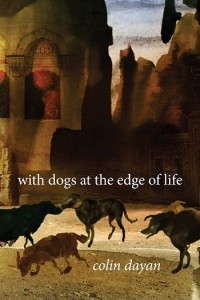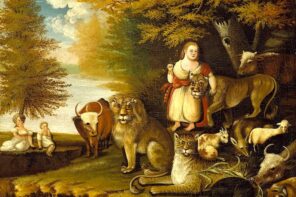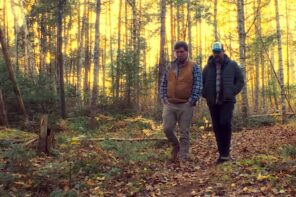The hottest news in animal life right now is a story about “religious” chimpanzees. A group of researchers believes that chimps may be engaging in ritualistic, but seemingly purposeless, stone throwing behaviors. Originally reported in the journal Nature as suggestive evidence that there may be more parallels between human and non-human ritualistic behavior than previously thought, the story has been feverishly touted by news outlets as evidence that chimps “believe in God.”
Ritual, which can include such behavior as tooth brushing, is not necessarily correlated with belief in the supernatural. But religion, in an age and culture that values science and hard data, looks to be chock-full of seemingly purposeless rituals. Hence a new and unfolding hope of our strange modern world: that our primate ancestors can help us prove that there’s nothing more natural for our animal bodies to undertake than seemingly purposeless ritual. This thing we call religion, in other words, is embedded into our evolutionary origins.
Alas, religion is a battleground, particularly when it comes to questions of creation and origin. Unsurprisingly, the simple observation that chimpanzees throw stones can lead to completely polarized speculative responses. On the one hand: the argument that this seemingly purposeless ritual behavior explains our seemingly purposeless religious rituals as merely an aspect of our biology. On the other hand: the argument that the presence of religious ritual in animal life testifies to the naturalness, or the inevitability, of religion and all its trimmings (i.e., religion is just something we’re designed to do as creatures).
These kinds of speculations grope after easy proof and simple certainties. Yet there is something about this vague, amorphous, and shape-shifting thing we call religion that resists these kinds of certainties. This is especially the case when religion intersects with animal bodies.
 With Dogs At The Edge of Life
With Dogs At The Edge of Life
Colin Dayan
Columbia University Press
December 2015
This is also not a scientific (or quasi-scientific) treatise on animals and religious life. Instead, Dayan’s book traces a spiritual itinerary that actively confounds our desire for hard data and certainty. Her reflections on creaturely experience, instead, dehumanize what we might otherwise think of as our religious experiences. As I read it, they render religion into a phenomenon less based on human qualities and characteristics, and more focused on mortal and animal concerns. This raises questions about where (and how) we encounter these ethereal things of the spirit in the first place. It is a book aimed to make “enlightened” people uncomfortable.
The book itself is a blend of things. Dayan incorporates memoir—reflecting on the dogs she has lived with, and loved—and meditates extensively on dog films such as the 1998 Mongolian State of Dogs or the 2013 Turkish Taşkafa: Stories of the Street. She also writes about controversial legal cases involving fighting dogs and the men who breed them. Her discussion of matters religious and spiritual is unsystematic, littered throughout the text in flickers and flashes.
“Dogs, she says, are ‘flesh shot through with spirit,’ who live ‘so adamantly in their bodies’ that they actually ‘become mind.’”
Dayan’s text is limned with a Christian sensibility: she consistently evokes the figure of Saint Paul, and speaks often of the interface between flesh and spirit in a manner that is resonant of the incarnation. She even recollects a period of her life when she intended to become a nun (and instead became a college professor). But this is not a dogmatic book. Rather, in this book, dogs are—non-dogmatically—something like spiritual teachers.
Dayan argues that dogs, as creatures, “bear the burden of revelation.” They “live on the track between the mental and the physical and sometimes seem to tease out a near-mystical disintegration of the bounds between them.” Dogs, she says, are “flesh shot through with spirit,” who live “so adamantly in their bodies” that they actually “become mind.”
What exactly does it mean, for dogs to confound or “mystically disintegrate” the lines between the spiritual and physical? Dayan writes, at one point, of being shocked to recognize the physical habits and behavior of one of her dead dogs resurrected in the body of one who was still alive—a physical habit that she’d never previously witnessed in this creature. This feels like a visit from the dead. Having felt an intense, familial love for her dogs, Dayan recalls their deaths with “all the stillness of worship.”
To see the ghost of one dog in the body of another stirs the archive of her memory in such a way that it leaves her asking questions about the boundaries between life and death. The ends of mortality, and the opening onto various forms of immortality, are topics often filed away in the warehouse of matters religious or theological. (Indeed, to reject religious identification often entails the abandonment of dreams of immortality.) In her glimpse into the world of the dead through the body of a living creature, however, Dayan illuminates how her physical contact with dogs tests the boundaries of her knowledge of spiritual things.
In evoking the way that dogs teach her about the life of the spirit, Dayan attributes to dogs what many refuse to attribute to anyone but human beings: something like spirit, a mind, or a soul. (Dayan is not particularly dogmatic about terms.) Many assume that the exclusion of other animals from spiritual things, or spiritual realities, is simply par for the course in monotheistic religious traditions. And yet, creaturely experience itself is derived from the basic categories of monotheistic theology—it is a form of experience that originates in a cosmology dominated by a creating creator and populated by its creatures.
Granted, within monotheistic thought there is certainly a ban on worshiping creatures—one must avoid idolatry—but this has never made for a full ban on understanding animals as spiritual teachers or as fellow travelers in the world of religious experiences. Indeed, biblical texts themselves, as well as the stories of early saints and martyrs in traditions such as Christianity, are populated with animals who bring spiritual lessons.
“…the question of who (or what) ‘counts’ as a creature is less a scientific question and more a religio-spiritual one.”
Dayan has been so affected by dogs that she even questions which came first: her commitment to faith, or her love of dogs. “Was I saddled with dogs, taking the obligation to care for them as the only serious task; and only then, having deprived myself of the things I once loved in order to be with them, did I turn to Saint Paul?” she asks. Or was it, instead, the case that she “already understood the renunciation necessary to receive Christ in me, and then the dogs arrived, all three of them, and I took them to be the form of my test of faith?” Ultimately, she does not answer this question of origin; she does not posit a thesis as to the origin of her own religious faith. Instead, she lets the relationship between the life of the spirit and the life of animals resonate more uncertainly.
Dayan’s erosion of certainties extends beyond the explicitly spiritual and religious. It becomes starkly apparent, for instance, that while this book is about animal life it is not a conventional book about animal ethics. Dayan upsets what have become somewhat conventional moral certainties regarding animal rights.
She is especially critical of animal advocacy organizations that claim, with an easy certainty, to bring humane treatment to the lives of animals. Through her examination of legal cases involving fighting dogs who were taken away from their breeders and exterminated for “humane” reasons, Dayan suggests that the “worst cruelties” often belong “to a politer world.” The abstract concern with “humane treatment and aversion to cruelty empowers those who sacrifice dogs and their owners to a judgment about what kind of human—and what kind of dog—is acceptable.” In other words, the fighting dogs of fighting men, she argues, “become the medium for, and ultimately suffer from, the intimidation, control, and debasement of humans.”
If this is not a book that supports conventional animal rights thinking, or provides clear guidelines when it comes to ethical reflection on animal life, or that uses scientific research to make arguments about the nature of our religious life as animals, then what (or who) is this book really for?
This is a book of questions. It is a book that queries the strange combination of pain and beauty in the fact of being alive. It is a book that ponders why it is that our meaty and fleshy existence so often seems shot through with something ethereal that cuts it open. It is a book that wonders in order to wonder. And it is a book that wonders why it is that animals—and our creaturely experience as animal beings—tend to get left out of spiritual accounts. What if dogs and gods were more than just anagrams?
The idea of creaturely experience is, itself, something messy and uncertain: what exactly is a creature? Is creatureliness something animal? Or is it something more expansively mortal—something, for instance, bacterial?
Creaturely experience is not, at the end of the day, a scientific concept. While it asserts that the empirical nature of creaturely bodies matters, the question of who (or what) “counts” as a creature is less a scientific question and more a religio-spiritual one. To take creaturely life and creaturely experience seriously is to ask new questions of religion and spirituality. It is a way of asking new questions about the animal nature of religion, without either pretending toward, or belittling, scientific knowledge. And it is to render our spiritual lives open to the inhuman in a new way—not focused merely on that which is super- or extra-human, but that which is nonhuman in a much more intimate and terrestrial way.
Dayan realizes that letting our “bond with dogs count for something monumentous”—taking the bonds and ties of creaturely life with the utmost seriousness—is a matter for more than just the animal rights activists, the humane societies, or those with a keen interest in biology. It is, instead, to acknowledge that we still know very little about life in the world. Dogs are one of the spirited forces that can clarify this—that can illuminate the worlds of knowledge beyond the human. Dayan’s is a book that leaves the reader hovering uncertainly and yet productively in front of something both freshly re-opened and newly interrogated. Living and thinking with dogs, she says, “we stand steadfast at the entry of something unknown, apparently impossible,” and something, “utterly enchanting.”
Also on The Cubit: What if Animals Believe in God?





